Competitive Strategy in Movie Exhibition: HI6006 Assignment
VerifiedAdded on 2023/03/17
|9
|2663
|82
Report
AI Summary
This report provides a comprehensive analysis of the competitive strategy employed by the movie exhibition industry. It begins with an overview of the industry's history, development, and growth, followed by an identification of its internal strengths and weaknesses, such as the use of advertisements and concession pricing, but also customer preference changes. The report then examines the external environment, including opportunities like technological advancements and threats such as competition from streaming services. A SWOT analysis is conducted, followed by an examination of corporate-level and business-level strategies, including cost leadership. The structure and control systems are also analyzed. The report concludes with recommendations for expanding business operations and enhancing competitiveness, such as diversifying business operations. The analysis incorporates academic sources and models studied in class, providing a detailed understanding of the industry's strategic landscape and potential improvements.
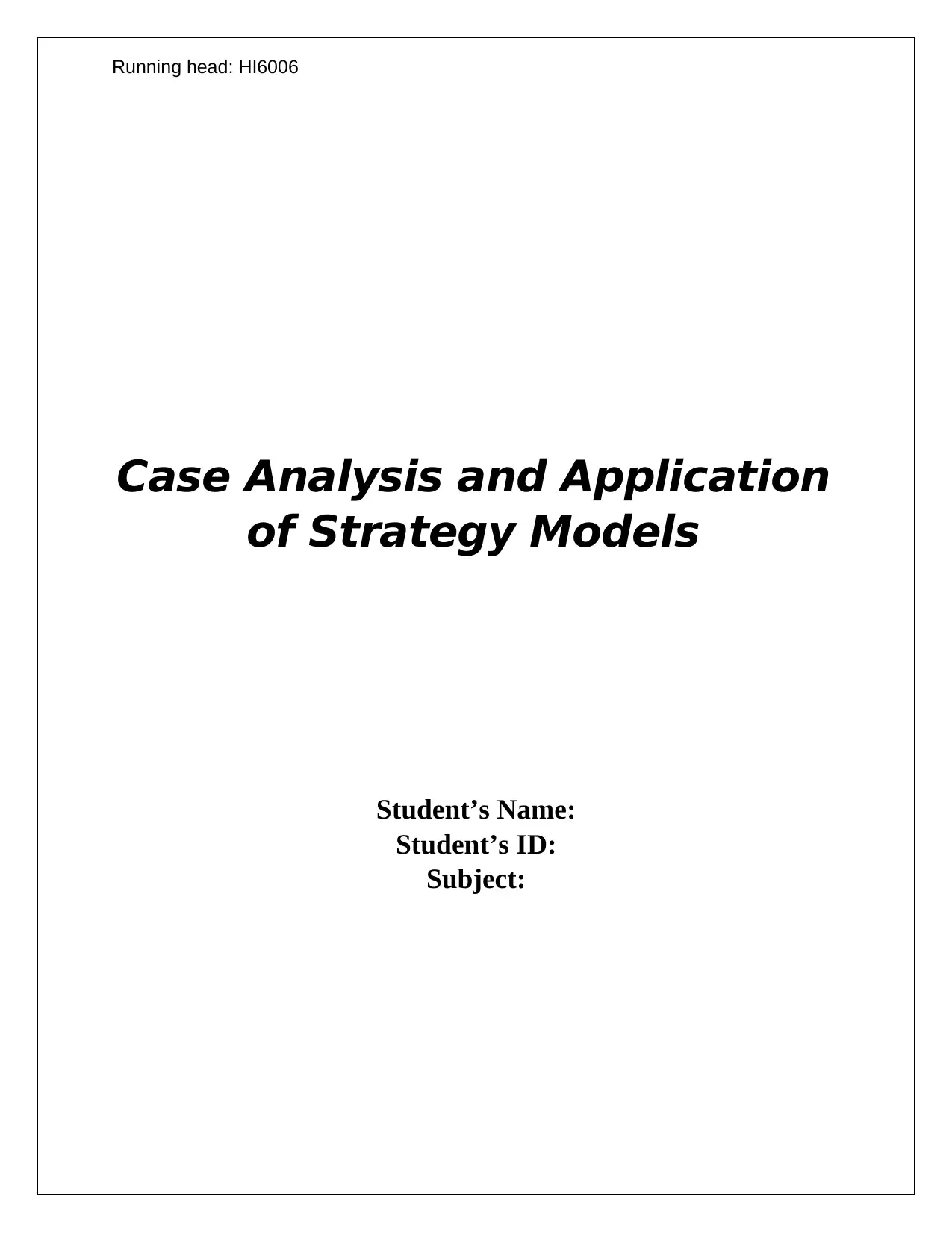
Running head: HI6006
Case Analysis and Application
of Strategy Models
Student’s Name:
Student’s ID:
Subject:
Case Analysis and Application
of Strategy Models
Student’s Name:
Student’s ID:
Subject:
Paraphrase This Document
Need a fresh take? Get an instant paraphrase of this document with our AI Paraphraser
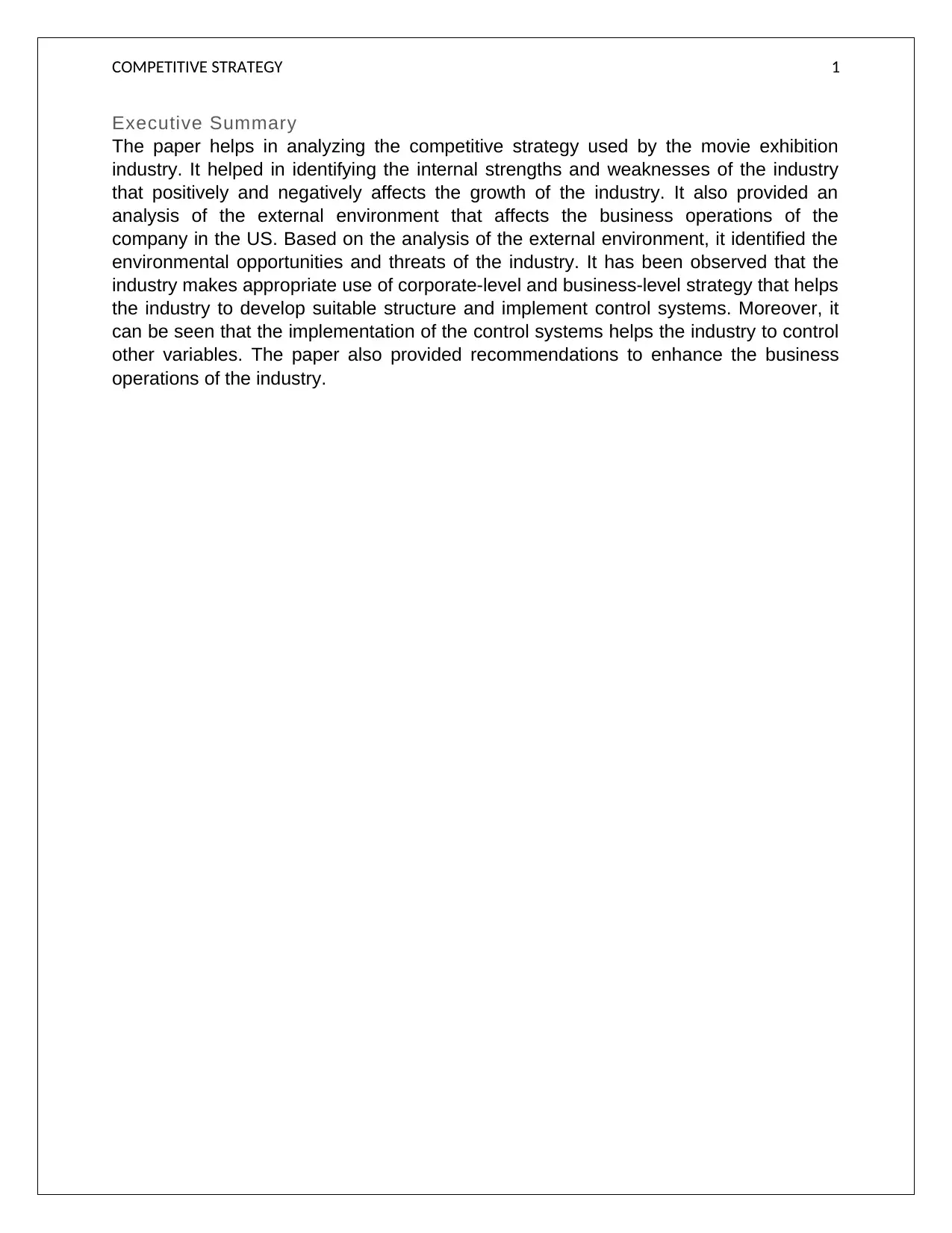
COMPETITIVE STRATEGY 1
Executive Summary
The paper helps in analyzing the competitive strategy used by the movie exhibition
industry. It helped in identifying the internal strengths and weaknesses of the industry
that positively and negatively affects the growth of the industry. It also provided an
analysis of the external environment that affects the business operations of the
company in the US. Based on the analysis of the external environment, it identified the
environmental opportunities and threats of the industry. It has been observed that the
industry makes appropriate use of corporate-level and business-level strategy that helps
the industry to develop suitable structure and implement control systems. Moreover, it
can be seen that the implementation of the control systems helps the industry to control
other variables. The paper also provided recommendations to enhance the business
operations of the industry.
Executive Summary
The paper helps in analyzing the competitive strategy used by the movie exhibition
industry. It helped in identifying the internal strengths and weaknesses of the industry
that positively and negatively affects the growth of the industry. It also provided an
analysis of the external environment that affects the business operations of the
company in the US. Based on the analysis of the external environment, it identified the
environmental opportunities and threats of the industry. It has been observed that the
industry makes appropriate use of corporate-level and business-level strategy that helps
the industry to develop suitable structure and implement control systems. Moreover, it
can be seen that the implementation of the control systems helps the industry to control
other variables. The paper also provided recommendations to enhance the business
operations of the industry.
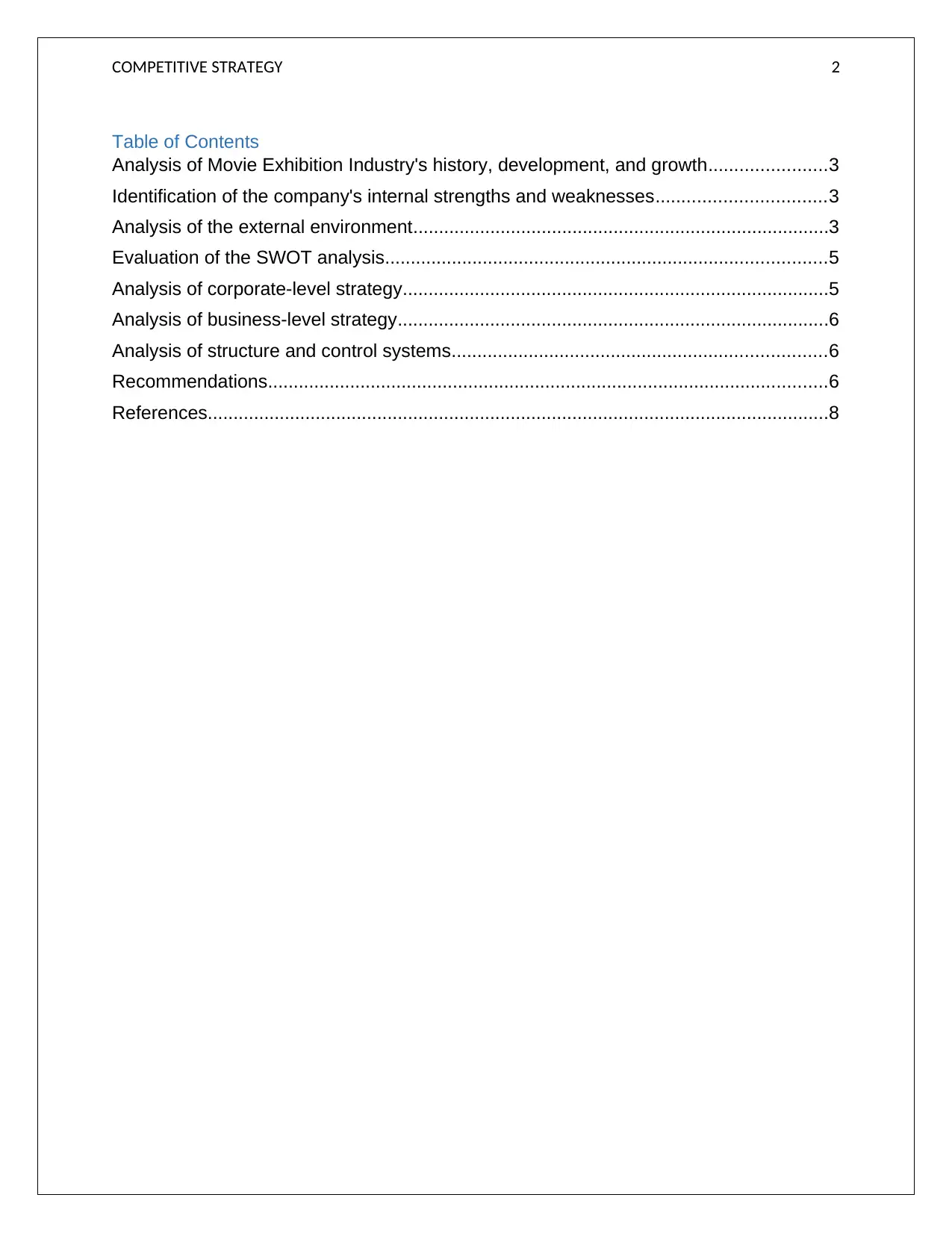
COMPETITIVE STRATEGY 2
Table of Contents
Analysis of Movie Exhibition Industry's history, development, and growth.......................3
Identification of the company's internal strengths and weaknesses.................................3
Analysis of the external environment.................................................................................3
Evaluation of the SWOT analysis......................................................................................5
Analysis of corporate-level strategy...................................................................................5
Analysis of business-level strategy....................................................................................6
Analysis of structure and control systems.........................................................................6
Recommendations.............................................................................................................6
References.........................................................................................................................8
Table of Contents
Analysis of Movie Exhibition Industry's history, development, and growth.......................3
Identification of the company's internal strengths and weaknesses.................................3
Analysis of the external environment.................................................................................3
Evaluation of the SWOT analysis......................................................................................5
Analysis of corporate-level strategy...................................................................................5
Analysis of business-level strategy....................................................................................6
Analysis of structure and control systems.........................................................................6
Recommendations.............................................................................................................6
References.........................................................................................................................8
⊘ This is a preview!⊘
Do you want full access?
Subscribe today to unlock all pages.

Trusted by 1+ million students worldwide

COMPETITIVE STRATEGY 3
Analysis of Movie Exhibition Industry's history, development, and growth
Since 1996, Ticket sales for movie exhibitions are at their lowest point. The exhibition is
determined to be the retail branch of the film industry. It includes the production and the
distribution of motion pictures as well as site devoted to screening the movie exhibition
for paying consumers. In the past decades, the film exhibitors have faced various critical
situations that put an impact on the commercial entertainment industry. Depending upon
the costly investments in new technologies, government regulatory actions, strong
competition, and shifting market conditions, the industry has put efforts to attain control
over the field (Kumb, Kunz and Siegert, 2017). Ticket sales and concession sales are
determined to be the two biggest revenue for Movie Theater that enhances the growth
of the movie exhibition industry. The industry follows the strategy of using technological
equipment’s to enhance their ticket sales. Based on this strategy, they negotiate the
percentage with the box office by initiating a contract with the exhibitions and studios.
Identification of the company's internal strengths and weaknesses
The Movie Exhibition Industry possess following internal strengths and weaknesses are
as follows:
Internal strengths
The significant strength of the industry is that entertainment is it makes wise use of
advertisements and concession pricing. It is determined to be a cheaper option as
compared to competitors (Prieto-Rodriguez, Gutierrez-Navratil and Ateca-Amestoy,
2015). The movie exhibition makes efficient use of digital screen technology to cater to
the screening schedules for the local audiences. Approximately 50% of the total screen
is considered to be 3D-enabled.
Internal weaknesses
The changing preferences of the customers are determined to be the major weakness
of the industry. The premium upgradation of tickets and dependence on revenue
concessions are effective but not consistent (Orhun, Venkataraman and Chintagunta,
2015). The overall health of the industry is affected due to more efficient alternatives.
Analysis of the external environment
The industry possesses some of the environmental opportunities, and threats are as
follows:
Opportunities
New advancement in technology and increasing number of films helps the movie
exhibition industry to facilitate exciting experience based on Movie exhibition (Bernardo,
Borrell and Perdiguero, 2016). The new venture enables independent production
studios to deliver their new movies to the exhibition companies.
Analysis of Movie Exhibition Industry's history, development, and growth
Since 1996, Ticket sales for movie exhibitions are at their lowest point. The exhibition is
determined to be the retail branch of the film industry. It includes the production and the
distribution of motion pictures as well as site devoted to screening the movie exhibition
for paying consumers. In the past decades, the film exhibitors have faced various critical
situations that put an impact on the commercial entertainment industry. Depending upon
the costly investments in new technologies, government regulatory actions, strong
competition, and shifting market conditions, the industry has put efforts to attain control
over the field (Kumb, Kunz and Siegert, 2017). Ticket sales and concession sales are
determined to be the two biggest revenue for Movie Theater that enhances the growth
of the movie exhibition industry. The industry follows the strategy of using technological
equipment’s to enhance their ticket sales. Based on this strategy, they negotiate the
percentage with the box office by initiating a contract with the exhibitions and studios.
Identification of the company's internal strengths and weaknesses
The Movie Exhibition Industry possess following internal strengths and weaknesses are
as follows:
Internal strengths
The significant strength of the industry is that entertainment is it makes wise use of
advertisements and concession pricing. It is determined to be a cheaper option as
compared to competitors (Prieto-Rodriguez, Gutierrez-Navratil and Ateca-Amestoy,
2015). The movie exhibition makes efficient use of digital screen technology to cater to
the screening schedules for the local audiences. Approximately 50% of the total screen
is considered to be 3D-enabled.
Internal weaknesses
The changing preferences of the customers are determined to be the major weakness
of the industry. The premium upgradation of tickets and dependence on revenue
concessions are effective but not consistent (Orhun, Venkataraman and Chintagunta,
2015). The overall health of the industry is affected due to more efficient alternatives.
Analysis of the external environment
The industry possesses some of the environmental opportunities, and threats are as
follows:
Opportunities
New advancement in technology and increasing number of films helps the movie
exhibition industry to facilitate exciting experience based on Movie exhibition (Bernardo,
Borrell and Perdiguero, 2016). The new venture enables independent production
studios to deliver their new movies to the exhibition companies.
Paraphrase This Document
Need a fresh take? Get an instant paraphrase of this document with our AI Paraphraser

COMPETITIVE STRATEGY 4
Threats
The increasing number of competition through alternative products is a major threat
facing the movie exhibition industry. The increasing demand for streaming services or
video subscriptions declines the market share of the industry. It also deals with the
threat of piracy as it encrypts all the files.
On the other, macro environmental factors that affect the movie exhibition industry are
as follows:
Demographic factors
Around 68% of US population prefers to watch movies at least once in a year. Out of
this, 49% of moviegoers are males, whereas 51% are females. In terms of age, the
largest proportion of moviegoers, around 22% comprise of 25-40 year old. All these
factors affect the growth of the industry (Legoux et al., 2016).
Political factors
The biggest political factor that affects the industry in the US is the availability of online
piracy for digital media. The industry also gets affected by the shared entertainment
media that is based on sharing and downloading the movies.
Economic factors
The movie exhibition industry is affected by the current US economic recession, but as
the customers prefer affordable forms of family entertainment, watching movies
becomes a smart, economical choice (Fox, 2015). The sale movie tickets in the US
helps the industry to view their highest return on concession sales.
Socio-cultural factors
There has been an increased demand for the movie exhibition industry due to the
multiple food offerings. As a result, the industry is affected by the threat of food labeling
that increases customer awareness.
Technological factors
The technological factors that affect the movie exhibition industry in the US are the
transformation from traditional film-based cinemas to digital cinemas. As a result, the
industry starts making use of 3-D digital technology and global ticket sales for creating
3-D movies (Chang and Chiu, 2016).
Ecological factors
The analysis of Porter's five forces model for movie exhibition industry are as follows:
Competitive rivalry
The intensity of competition among the rivals in the movie exhibition industry is
moderate to high. The existing rivals within the international market are struggling to
gain customer loyalty and more admissions.
Threats
The increasing number of competition through alternative products is a major threat
facing the movie exhibition industry. The increasing demand for streaming services or
video subscriptions declines the market share of the industry. It also deals with the
threat of piracy as it encrypts all the files.
On the other, macro environmental factors that affect the movie exhibition industry are
as follows:
Demographic factors
Around 68% of US population prefers to watch movies at least once in a year. Out of
this, 49% of moviegoers are males, whereas 51% are females. In terms of age, the
largest proportion of moviegoers, around 22% comprise of 25-40 year old. All these
factors affect the growth of the industry (Legoux et al., 2016).
Political factors
The biggest political factor that affects the industry in the US is the availability of online
piracy for digital media. The industry also gets affected by the shared entertainment
media that is based on sharing and downloading the movies.
Economic factors
The movie exhibition industry is affected by the current US economic recession, but as
the customers prefer affordable forms of family entertainment, watching movies
becomes a smart, economical choice (Fox, 2015). The sale movie tickets in the US
helps the industry to view their highest return on concession sales.
Socio-cultural factors
There has been an increased demand for the movie exhibition industry due to the
multiple food offerings. As a result, the industry is affected by the threat of food labeling
that increases customer awareness.
Technological factors
The technological factors that affect the movie exhibition industry in the US are the
transformation from traditional film-based cinemas to digital cinemas. As a result, the
industry starts making use of 3-D digital technology and global ticket sales for creating
3-D movies (Chang and Chiu, 2016).
Ecological factors
The analysis of Porter's five forces model for movie exhibition industry are as follows:
Competitive rivalry
The intensity of competition among the rivals in the movie exhibition industry is
moderate to high. The existing rivals within the international market are struggling to
gain customer loyalty and more admissions.
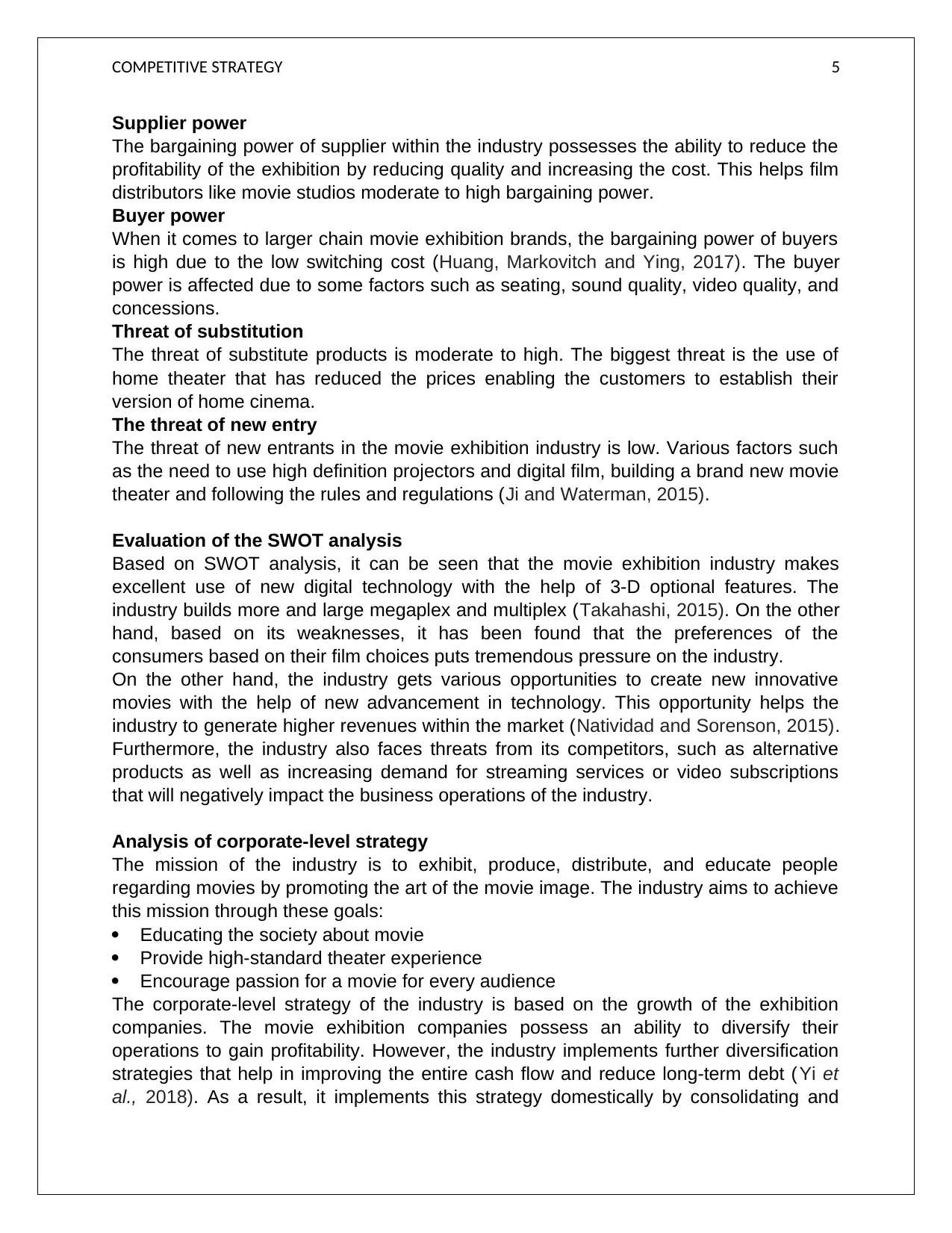
COMPETITIVE STRATEGY 5
Supplier power
The bargaining power of supplier within the industry possesses the ability to reduce the
profitability of the exhibition by reducing quality and increasing the cost. This helps film
distributors like movie studios moderate to high bargaining power.
Buyer power
When it comes to larger chain movie exhibition brands, the bargaining power of buyers
is high due to the low switching cost (Huang, Markovitch and Ying, 2017). The buyer
power is affected due to some factors such as seating, sound quality, video quality, and
concessions.
Threat of substitution
The threat of substitute products is moderate to high. The biggest threat is the use of
home theater that has reduced the prices enabling the customers to establish their
version of home cinema.
The threat of new entry
The threat of new entrants in the movie exhibition industry is low. Various factors such
as the need to use high definition projectors and digital film, building a brand new movie
theater and following the rules and regulations (Ji and Waterman, 2015).
Evaluation of the SWOT analysis
Based on SWOT analysis, it can be seen that the movie exhibition industry makes
excellent use of new digital technology with the help of 3-D optional features. The
industry builds more and large megaplex and multiplex (Takahashi, 2015). On the other
hand, based on its weaknesses, it has been found that the preferences of the
consumers based on their film choices puts tremendous pressure on the industry.
On the other hand, the industry gets various opportunities to create new innovative
movies with the help of new advancement in technology. This opportunity helps the
industry to generate higher revenues within the market (Natividad and Sorenson, 2015).
Furthermore, the industry also faces threats from its competitors, such as alternative
products as well as increasing demand for streaming services or video subscriptions
that will negatively impact the business operations of the industry.
Analysis of corporate-level strategy
The mission of the industry is to exhibit, produce, distribute, and educate people
regarding movies by promoting the art of the movie image. The industry aims to achieve
this mission through these goals:
Educating the society about movie
Provide high-standard theater experience
Encourage passion for a movie for every audience
The corporate-level strategy of the industry is based on the growth of the exhibition
companies. The movie exhibition companies possess an ability to diversify their
operations to gain profitability. However, the industry implements further diversification
strategies that help in improving the entire cash flow and reduce long-term debt ( Yi et
al., 2018). As a result, it implements this strategy domestically by consolidating and
Supplier power
The bargaining power of supplier within the industry possesses the ability to reduce the
profitability of the exhibition by reducing quality and increasing the cost. This helps film
distributors like movie studios moderate to high bargaining power.
Buyer power
When it comes to larger chain movie exhibition brands, the bargaining power of buyers
is high due to the low switching cost (Huang, Markovitch and Ying, 2017). The buyer
power is affected due to some factors such as seating, sound quality, video quality, and
concessions.
Threat of substitution
The threat of substitute products is moderate to high. The biggest threat is the use of
home theater that has reduced the prices enabling the customers to establish their
version of home cinema.
The threat of new entry
The threat of new entrants in the movie exhibition industry is low. Various factors such
as the need to use high definition projectors and digital film, building a brand new movie
theater and following the rules and regulations (Ji and Waterman, 2015).
Evaluation of the SWOT analysis
Based on SWOT analysis, it can be seen that the movie exhibition industry makes
excellent use of new digital technology with the help of 3-D optional features. The
industry builds more and large megaplex and multiplex (Takahashi, 2015). On the other
hand, based on its weaknesses, it has been found that the preferences of the
consumers based on their film choices puts tremendous pressure on the industry.
On the other hand, the industry gets various opportunities to create new innovative
movies with the help of new advancement in technology. This opportunity helps the
industry to generate higher revenues within the market (Natividad and Sorenson, 2015).
Furthermore, the industry also faces threats from its competitors, such as alternative
products as well as increasing demand for streaming services or video subscriptions
that will negatively impact the business operations of the industry.
Analysis of corporate-level strategy
The mission of the industry is to exhibit, produce, distribute, and educate people
regarding movies by promoting the art of the movie image. The industry aims to achieve
this mission through these goals:
Educating the society about movie
Provide high-standard theater experience
Encourage passion for a movie for every audience
The corporate-level strategy of the industry is based on the growth of the exhibition
companies. The movie exhibition companies possess an ability to diversify their
operations to gain profitability. However, the industry implements further diversification
strategies that help in improving the entire cash flow and reduce long-term debt ( Yi et
al., 2018). As a result, it implements this strategy domestically by consolidating and
⊘ This is a preview!⊘
Do you want full access?
Subscribe today to unlock all pages.

Trusted by 1+ million students worldwide
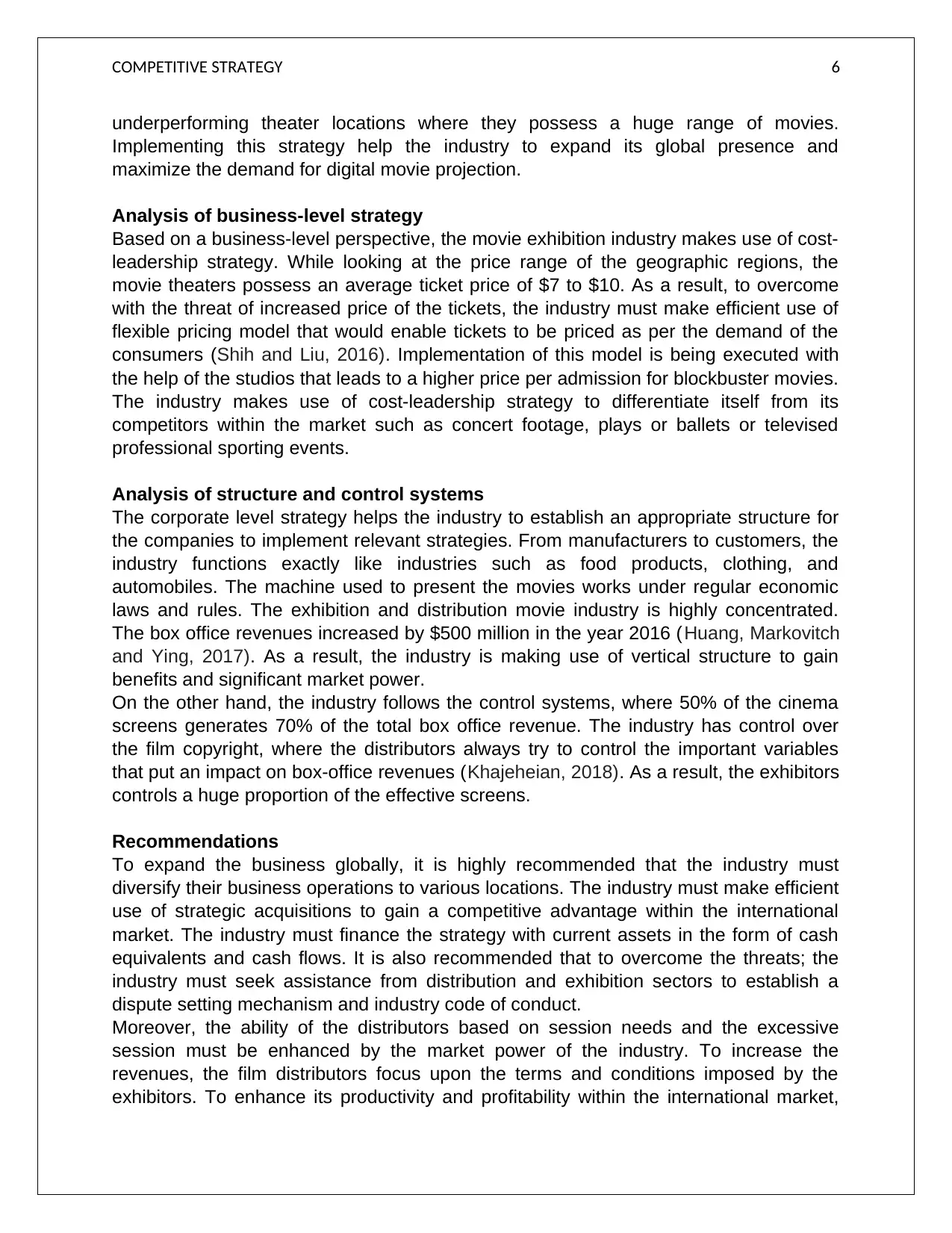
COMPETITIVE STRATEGY 6
underperforming theater locations where they possess a huge range of movies.
Implementing this strategy help the industry to expand its global presence and
maximize the demand for digital movie projection.
Analysis of business-level strategy
Based on a business-level perspective, the movie exhibition industry makes use of cost-
leadership strategy. While looking at the price range of the geographic regions, the
movie theaters possess an average ticket price of $7 to $10. As a result, to overcome
with the threat of increased price of the tickets, the industry must make efficient use of
flexible pricing model that would enable tickets to be priced as per the demand of the
consumers (Shih and Liu, 2016). Implementation of this model is being executed with
the help of the studios that leads to a higher price per admission for blockbuster movies.
The industry makes use of cost-leadership strategy to differentiate itself from its
competitors within the market such as concert footage, plays or ballets or televised
professional sporting events.
Analysis of structure and control systems
The corporate level strategy helps the industry to establish an appropriate structure for
the companies to implement relevant strategies. From manufacturers to customers, the
industry functions exactly like industries such as food products, clothing, and
automobiles. The machine used to present the movies works under regular economic
laws and rules. The exhibition and distribution movie industry is highly concentrated.
The box office revenues increased by $500 million in the year 2016 (Huang, Markovitch
and Ying, 2017). As a result, the industry is making use of vertical structure to gain
benefits and significant market power.
On the other hand, the industry follows the control systems, where 50% of the cinema
screens generates 70% of the total box office revenue. The industry has control over
the film copyright, where the distributors always try to control the important variables
that put an impact on box-office revenues (Khajeheian, 2018). As a result, the exhibitors
controls a huge proportion of the effective screens.
Recommendations
To expand the business globally, it is highly recommended that the industry must
diversify their business operations to various locations. The industry must make efficient
use of strategic acquisitions to gain a competitive advantage within the international
market. The industry must finance the strategy with current assets in the form of cash
equivalents and cash flows. It is also recommended that to overcome the threats; the
industry must seek assistance from distribution and exhibition sectors to establish a
dispute setting mechanism and industry code of conduct.
Moreover, the ability of the distributors based on session needs and the excessive
session must be enhanced by the market power of the industry. To increase the
revenues, the film distributors focus upon the terms and conditions imposed by the
exhibitors. To enhance its productivity and profitability within the international market,
underperforming theater locations where they possess a huge range of movies.
Implementing this strategy help the industry to expand its global presence and
maximize the demand for digital movie projection.
Analysis of business-level strategy
Based on a business-level perspective, the movie exhibition industry makes use of cost-
leadership strategy. While looking at the price range of the geographic regions, the
movie theaters possess an average ticket price of $7 to $10. As a result, to overcome
with the threat of increased price of the tickets, the industry must make efficient use of
flexible pricing model that would enable tickets to be priced as per the demand of the
consumers (Shih and Liu, 2016). Implementation of this model is being executed with
the help of the studios that leads to a higher price per admission for blockbuster movies.
The industry makes use of cost-leadership strategy to differentiate itself from its
competitors within the market such as concert footage, plays or ballets or televised
professional sporting events.
Analysis of structure and control systems
The corporate level strategy helps the industry to establish an appropriate structure for
the companies to implement relevant strategies. From manufacturers to customers, the
industry functions exactly like industries such as food products, clothing, and
automobiles. The machine used to present the movies works under regular economic
laws and rules. The exhibition and distribution movie industry is highly concentrated.
The box office revenues increased by $500 million in the year 2016 (Huang, Markovitch
and Ying, 2017). As a result, the industry is making use of vertical structure to gain
benefits and significant market power.
On the other hand, the industry follows the control systems, where 50% of the cinema
screens generates 70% of the total box office revenue. The industry has control over
the film copyright, where the distributors always try to control the important variables
that put an impact on box-office revenues (Khajeheian, 2018). As a result, the exhibitors
controls a huge proportion of the effective screens.
Recommendations
To expand the business globally, it is highly recommended that the industry must
diversify their business operations to various locations. The industry must make efficient
use of strategic acquisitions to gain a competitive advantage within the international
market. The industry must finance the strategy with current assets in the form of cash
equivalents and cash flows. It is also recommended that to overcome the threats; the
industry must seek assistance from distribution and exhibition sectors to establish a
dispute setting mechanism and industry code of conduct.
Moreover, the ability of the distributors based on session needs and the excessive
session must be enhanced by the market power of the industry. To increase the
revenues, the film distributors focus upon the terms and conditions imposed by the
exhibitors. To enhance its productivity and profitability within the international market,
Paraphrase This Document
Need a fresh take? Get an instant paraphrase of this document with our AI Paraphraser
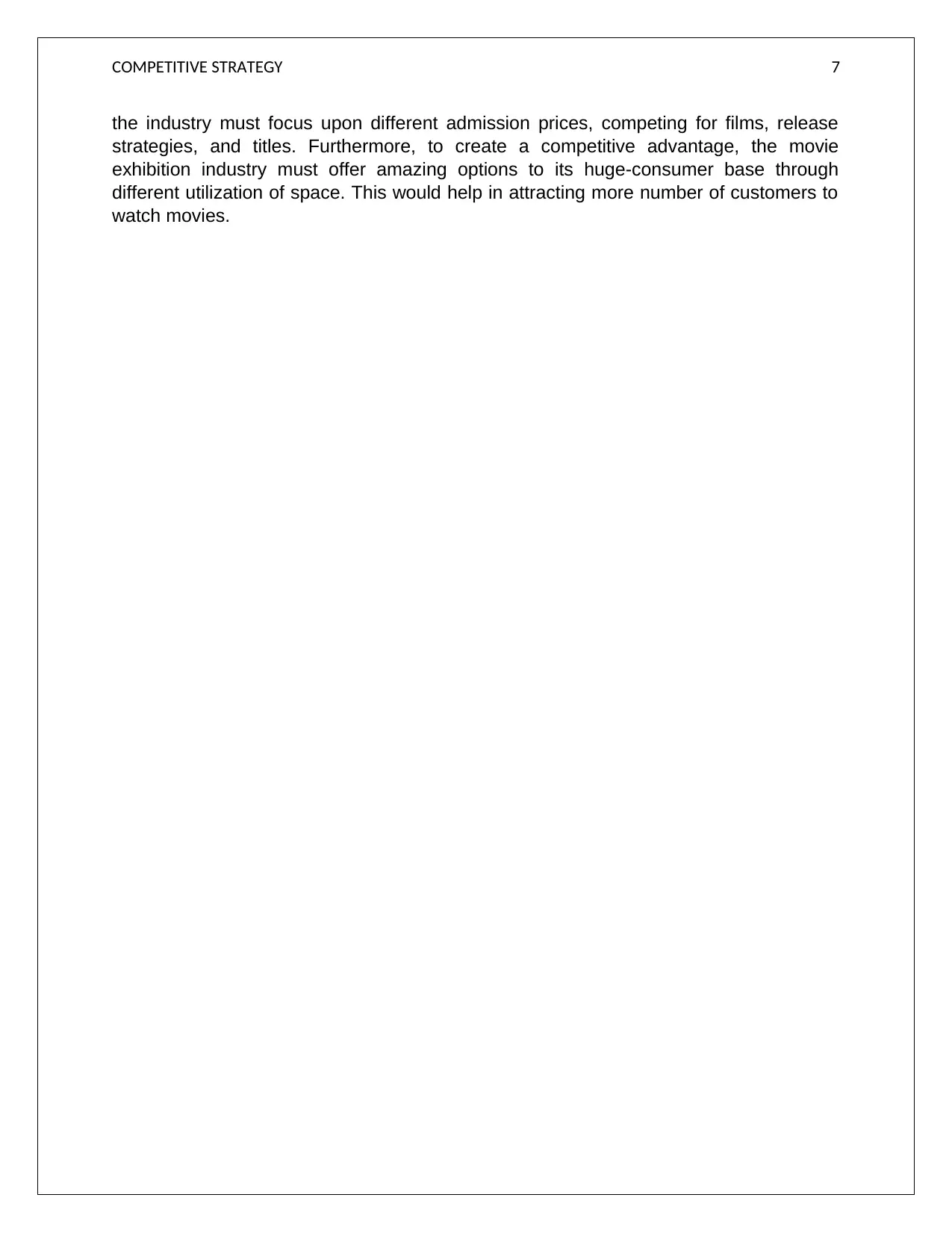
COMPETITIVE STRATEGY 7
the industry must focus upon different admission prices, competing for films, release
strategies, and titles. Furthermore, to create a competitive advantage, the movie
exhibition industry must offer amazing options to its huge-consumer base through
different utilization of space. This would help in attracting more number of customers to
watch movies.
the industry must focus upon different admission prices, competing for films, release
strategies, and titles. Furthermore, to create a competitive advantage, the movie
exhibition industry must offer amazing options to its huge-consumer base through
different utilization of space. This would help in attracting more number of customers to
watch movies.
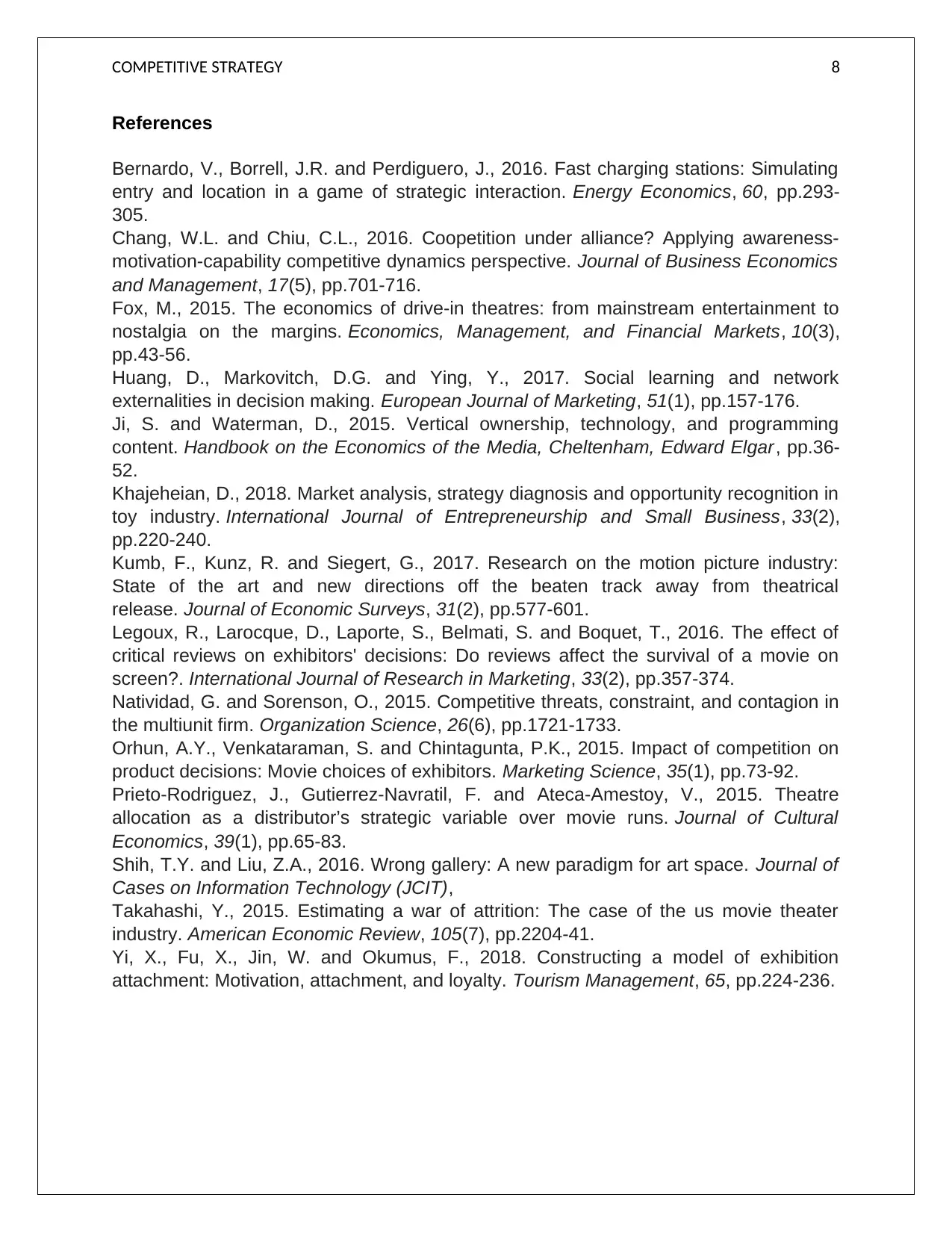
COMPETITIVE STRATEGY 8
References
Bernardo, V., Borrell, J.R. and Perdiguero, J., 2016. Fast charging stations: Simulating
entry and location in a game of strategic interaction. Energy Economics, 60, pp.293-
305.
Chang, W.L. and Chiu, C.L., 2016. Coopetition under alliance? Applying awareness-
motivation-capability competitive dynamics perspective. Journal of Business Economics
and Management, 17(5), pp.701-716.
Fox, M., 2015. The economics of drive-in theatres: from mainstream entertainment to
nostalgia on the margins. Economics, Management, and Financial Markets, 10(3),
pp.43-56.
Huang, D., Markovitch, D.G. and Ying, Y., 2017. Social learning and network
externalities in decision making. European Journal of Marketing, 51(1), pp.157-176.
Ji, S. and Waterman, D., 2015. Vertical ownership, technology, and programming
content. Handbook on the Economics of the Media, Cheltenham, Edward Elgar, pp.36-
52.
Khajeheian, D., 2018. Market analysis, strategy diagnosis and opportunity recognition in
toy industry. International Journal of Entrepreneurship and Small Business, 33(2),
pp.220-240.
Kumb, F., Kunz, R. and Siegert, G., 2017. Research on the motion picture industry:
State of the art and new directions off the beaten track away from theatrical
release. Journal of Economic Surveys, 31(2), pp.577-601.
Legoux, R., Larocque, D., Laporte, S., Belmati, S. and Boquet, T., 2016. The effect of
critical reviews on exhibitors' decisions: Do reviews affect the survival of a movie on
screen?. International Journal of Research in Marketing, 33(2), pp.357-374.
Natividad, G. and Sorenson, O., 2015. Competitive threats, constraint, and contagion in
the multiunit firm. Organization Science, 26(6), pp.1721-1733.
Orhun, A.Y., Venkataraman, S. and Chintagunta, P.K., 2015. Impact of competition on
product decisions: Movie choices of exhibitors. Marketing Science, 35(1), pp.73-92.
Prieto-Rodriguez, J., Gutierrez-Navratil, F. and Ateca-Amestoy, V., 2015. Theatre
allocation as a distributor’s strategic variable over movie runs. Journal of Cultural
Economics, 39(1), pp.65-83.
Shih, T.Y. and Liu, Z.A., 2016. Wrong gallery: A new paradigm for art space. Journal of
Cases on Information Technology (JCIT),
Takahashi, Y., 2015. Estimating a war of attrition: The case of the us movie theater
industry. American Economic Review, 105(7), pp.2204-41.
Yi, X., Fu, X., Jin, W. and Okumus, F., 2018. Constructing a model of exhibition
attachment: Motivation, attachment, and loyalty. Tourism Management, 65, pp.224-236.
References
Bernardo, V., Borrell, J.R. and Perdiguero, J., 2016. Fast charging stations: Simulating
entry and location in a game of strategic interaction. Energy Economics, 60, pp.293-
305.
Chang, W.L. and Chiu, C.L., 2016. Coopetition under alliance? Applying awareness-
motivation-capability competitive dynamics perspective. Journal of Business Economics
and Management, 17(5), pp.701-716.
Fox, M., 2015. The economics of drive-in theatres: from mainstream entertainment to
nostalgia on the margins. Economics, Management, and Financial Markets, 10(3),
pp.43-56.
Huang, D., Markovitch, D.G. and Ying, Y., 2017. Social learning and network
externalities in decision making. European Journal of Marketing, 51(1), pp.157-176.
Ji, S. and Waterman, D., 2015. Vertical ownership, technology, and programming
content. Handbook on the Economics of the Media, Cheltenham, Edward Elgar, pp.36-
52.
Khajeheian, D., 2018. Market analysis, strategy diagnosis and opportunity recognition in
toy industry. International Journal of Entrepreneurship and Small Business, 33(2),
pp.220-240.
Kumb, F., Kunz, R. and Siegert, G., 2017. Research on the motion picture industry:
State of the art and new directions off the beaten track away from theatrical
release. Journal of Economic Surveys, 31(2), pp.577-601.
Legoux, R., Larocque, D., Laporte, S., Belmati, S. and Boquet, T., 2016. The effect of
critical reviews on exhibitors' decisions: Do reviews affect the survival of a movie on
screen?. International Journal of Research in Marketing, 33(2), pp.357-374.
Natividad, G. and Sorenson, O., 2015. Competitive threats, constraint, and contagion in
the multiunit firm. Organization Science, 26(6), pp.1721-1733.
Orhun, A.Y., Venkataraman, S. and Chintagunta, P.K., 2015. Impact of competition on
product decisions: Movie choices of exhibitors. Marketing Science, 35(1), pp.73-92.
Prieto-Rodriguez, J., Gutierrez-Navratil, F. and Ateca-Amestoy, V., 2015. Theatre
allocation as a distributor’s strategic variable over movie runs. Journal of Cultural
Economics, 39(1), pp.65-83.
Shih, T.Y. and Liu, Z.A., 2016. Wrong gallery: A new paradigm for art space. Journal of
Cases on Information Technology (JCIT),
Takahashi, Y., 2015. Estimating a war of attrition: The case of the us movie theater
industry. American Economic Review, 105(7), pp.2204-41.
Yi, X., Fu, X., Jin, W. and Okumus, F., 2018. Constructing a model of exhibition
attachment: Motivation, attachment, and loyalty. Tourism Management, 65, pp.224-236.
⊘ This is a preview!⊘
Do you want full access?
Subscribe today to unlock all pages.

Trusted by 1+ million students worldwide
1 out of 9
Related Documents
Your All-in-One AI-Powered Toolkit for Academic Success.
+13062052269
info@desklib.com
Available 24*7 on WhatsApp / Email
![[object Object]](/_next/static/media/star-bottom.7253800d.svg)
Unlock your academic potential
Copyright © 2020–2025 A2Z Services. All Rights Reserved. Developed and managed by ZUCOL.





